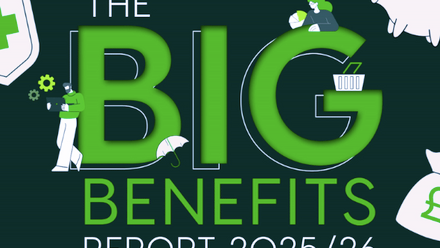Webinar Q&A: Changing employee recognition plans
In this follow-up Q&A, panel members Roger Fairhead, group reward director, Legal & General Group; and Trish West, head of reward, ATS Euromaster, address the key questions we ran out of time to ask.
If you missed the webinar, you can still watch the Changing employee recognition plans recording.

Getting buy-in for recognition
Q. How can we get businesses to understand the value in rewards? And the type of rewards?
Trish: You need to demonstrate a link between reward and business performance and objectives – it depends what you’re trying to achieve. You also need to know your employees – a theme that is coming through a lot of these questions is the need to understand your employees and what motivates them. Don’t offer rewards that are clearly not appropriate for your workforce.
Q. Our struggle is currently to change the mindset that recognition can have significant impacts/benefits to other people teams (higher retention, lower sickness, higher perception of inclusion). Any advice?
Roger: I similarly struggled for many years with the same resistance – employees get paid/bonuses/verbally thanked…why do they need any further recognition?! A justification that I have used in such instances is that a recognition programme is not just about thanking a particular employee, but being able showcase/highlight what that employee has done as an example for other employees to emulate. A recognition programme communicates, replicates and inspires good performance across the whole organisation, which a discrete bonus/thank you to an individual could never achieve.
Q. How does a specialist in recognition (non-monetary rewards) help to explain the investment and benefits to the traditional people teams (talent management, talent attraction) and newer people teams (diversity, equality, inclusion, wellbeing)?
Trish: You all work for the same organisation and you share the same purpose. The challenge is how do you work together to achieve that? What is your engagement survey telling you? What research or data can you find to show how your employees are feeling about reward and recognition, and then that will naturally link into other parts of HR when you’re having those functional discussions.
Q. I'd be interested in understanding a little more about the feedback from employees as to how they feel about being recognised where there is no financial gain. We are struggling to engage the business in seeing the value of recognition for recognition's sake, and that it doesn't have to come with any monetary value.
Roger: Seemingly employees are pleased to be recognised, even though there is no financial reward. I judge that on the basis that the number of nominations each month has remained fairly constant throughout the period since implementation in August 2020 (at c.10% of employees each month). Their achievement is broadly publicised across the organisation, and enables them to be recognised beyond their immediate team/department/function. It will have helped us that we have never made monetary awards – I can understand why it will be more difficult to change from monetary to no monetary value.
How to recognise different groups of employees
Q. Any suggestions on how we recognise and reward employees who aren't in sales roles?
Trish: Again it depends on what you’re trying to achieve. There has to be a link between your non-sales employees and business performance, so try and build your reward programme around that – how do non-sales employees contribute to business success? How can you measure it? What are the KPIs?
What that reward or recognition might look like really depends on the business and your objectives, as well as the demographics of your workforce.
Roger: The sales team can only sell if the production team have made it, the design team have designed it, the supply chain team have delivered it, the finance team have financed it, and the HR team have ensured all the people are in place to make that process happen! I’m not suggesting that a recognition programme can solve all of that, but if you were to create meaningful categories that recognise other functions (e.g. recognise someone in the finance team who recovered a bad debt) that might help start to redress the imbalance.
Q. Any tips on engaging shift workers/non-office workers with a recognition scheme? We struggle with employees who are not 'online'
Trish: I know first-hand how difficult this can be, especially where you have employees who are not online. But ultimately it goes back to understanding the demographics of your workforce. Are they concentrated in one or two large sites, or are they dispersed in small groups around the country? What technology and communication channels are available to you? You need to understand all this as it will help you to discover the best ways to get out to people.
You can use technology, paper-based systems, face-to-face presentations, publicity materials in staff rooms and canteens, and develop local benefit champions – are there people at key sites who could be the ‘go-to’ person for benefits and recognition? You could do line manager briefings, company briefings, but you need to tailor the materials to the audience and use language that is understood. Keep it plain and simple.
If finances permit, consider investing in an employee benefits platform that employees can access using their personal phones, as that can provide another way of reaching remote employees. Finally, think about when to communicate – arrange presentations before the start of shifts – remote workers really do appreciate having someone do a presentation to them as it makes them feel part of the community.
Q. What are the panel's thoughts on excluding management from recognition programmes or at least having something different?
Roger: I favour excluding senior grades from “winning” a recognition award, particularly if financial value is attached. Recognition is an opportunity to highlight/showcase/celebrate those (typically lower grade) employees who don’t ordinarily get the limelight.
Managing different types of recognition schemes
Q. How do you ensure a consistent approach across the board? Is one person the gatekeeper for who gets recognised so that there is this a consistent approach to recognition?
Trish: Consistency in your recognition scheme is vital if it is going to be viewed as credible amongst employees.
If you have a prestigious annual awards scheme or a recognition scheme where there’s a financial reward, it will almost certainly require more structured vetting of your award nominations than say a non-monetary scheme.
Where it is a non-monetary scheme you could have a gatekeeper, if you and your team have the capacity, but it can become an onerous task. What you want is for recognition to become more prevalent across the organisation, so if you are going to police recognition in any way, it needs to be light touch or at a fairly high level.
Be careful not to take away the spontaneity of an award. Make the recognition criteria as clear as possible and educate managers and employees on how to use them.
Q. Roger – do all recognition nominees get the award or is there a judging panel/process? If so, how does this work?
Roger: There is no judging panel, but based solely on a published leader board showing the top five “senders” and “receivers” of recognition awards. The top “receiver” under each category (which reflects each of our “behaviours” – Straightforward, Purposeful and Collaborative) is then highlighted in a group-wide communication explaining what they have done, and why that is worthy of being recognised/celebrated.
Q. I’d be interesting to understand the decision to include a leader board/competition? As there is various articles about including calling out great examples but not including competition (as competition can have negative impacts).
Roger: Yes, initially I had a similar concern about the negative impact of competition. However, it seems to work well because any employee can nominate any other employee, so it’s very democratic and perhaps that helps avoid any negativity of competition. For example, if I (as an employee) don’t think the leader board appropriately reflects the contribution of some employees I have appreciated during the month (but may have forgotten to formally recognise through the platform) I can immediately go online to recognise them, and perhaps also encourage some of my colleagues to do the same, and see in real time how that impacts the leader board. There is no senior management over-ride, and each employee’s vote counts equally, so it’s a very transparent democracy in real time.
Q. Does anyone have experience of moving away from long service schemes and reinvesting this money into more in the moment peer-to-peer recognition? How do we do this without it coming across as something we are taking away from employees?
Trish: Does it need to be an either/or situation? Could you actually do both? There are merits in long service schemes and more strategic approaches.
See this as an opportunity to evolve your schemes and combine them as an overall recognition strategy. You could look to rebrand and relaunch and then present it to show that all employees can benefit from a wide range of recognition tools, not just long service.
Q. We have paused our long service recognition, which included extra holidays, due to a challenge they are ageist – does the panel have any thoughts/experience on this please?
Trish: Many companies offer service-related holidays, and could (or may not be) part of a long-service awards scheme. These schemes are typically there to recognise employee loyalty and commitment to the company, rather than being something specifically related to the employee’s age.
In defence of long service awards, they’re a fair and objective form of recognition. You either achieve the service milestone or you don’t. They’re based on hard facts, and they’re not based around subjective judgement in the way that peer-to-peer or manager recognition schemes can be. They also don’t have to be ‘long’ service awards – you can recognise 1, 3, 5 years’ service.
Final thoughts
Q. Does recognition have any connection with performance reviews/annual pay rewards? Are there any unintended connections to compensation?
Roger: There is no connection between someone receiving a recognition award and their performance review/pay/bonus. They are separate systems. However, I would expect a high degree of correlation (e.g. someone receiving a recognition award is likely to be a high performer/contributor, and therefore they are likely to receive a higher performance rating/pay increase/bonus). We have not compared the datasets, but I would be surprised if there was no correlation.
Q. How do you keep a recognition scheme feeling fresh so that people continue to engage?
Trish: A lot of hard work is involved in keeping things fresh and people interested. If I have one tip it would to become best friends with your in-house communications team because you’ll find that that person will be a real ally to you in this. Use a variety of communications tools, whether that’s online, hard copy posters, leaflets you can get loads of branded collateral, use face-to-face meetings. So it’s using different tools at different times to keep things fresh so you’re not always communicating in the same old way.
For more insights on this topic, watch the webinar recording.






